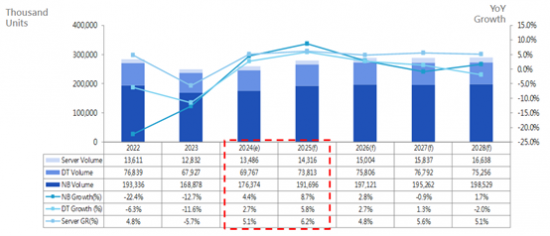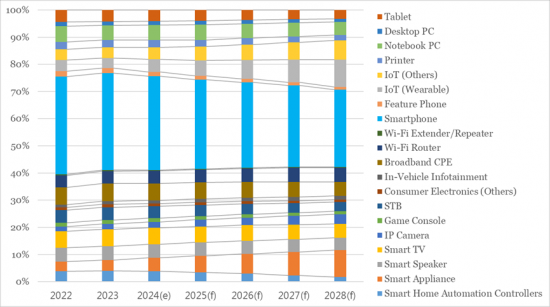
이 보고서는 세계의 노트북, 데스크톱 PC, 서버 마더보드, Wi-Fi 연결 장치, 스마트폰 업계의 개황을 종합적으로 조사함과 동시에 향후 5년간(2024-2028년) 시장 규모의 동향 전망을 예측했습니다.
세계의 PC 출하량은 2024년 2억 4,610만 대, 2025년 전년 대비 8.3% 증가한 2억 6,550만 대에 달할 것으로 예측됩니다. 2024년부터 2028년까지 CAGR(연간 평균 성장률)은 2.7%로 추정됩니다. 이 보고서에서는 노트북과 데스크톱 PC를 포함한 기존 PC에 초점을 맞추고 태블릿은 조사 대상이 아닙니다.

주1 : GR=전년대비 성장률 주2 : 데스크톱(DT) 제품 수치는 AIO PC(올인원 PC) 수치 포함
조사 대상 기업에는 ODM· OEM· EMS· CEM· OBM· 프라이빗 브랜드 사업을 전개하는 대만 노트북 제조업체가 포함되어 있으며, 생산 거점 및 출하처에는 대만· 중국· 일본· 한국· 동남아시아, 북미, 라틴아메리카, 서유럽 및 기타 유럽 국가 및 기타 지역을 포함합니다.
세계 경기침체가 계속되는 가운데 세계의 노트북 시장은 2023년에도 저조하게 추이했습니다. 그럼에도 불구하고 2년 연속 수요 감소를 겪었고 노트북 공급망 제조업체는 2024년 회복을 낙관시하고 있습니다.
세계의 데스크톱 PC 업계는 2023년에 상당한 하락을 보였으며 출하 대수는 6,792만 7,000대로 2022년부터 11.6% 감소했습니다. 데스크톱 PC 공급망의 과잉 재고가 해소되고 재고 수준이 건전화되었음에도 불구하고 시장은 세계 경제 침체와 고인플레이션 비율의 영향을 계속 받아 PC 제품에 대한 소비자 수요 침체가 계속됩니다. 네.
본 보고서에서는 광범위한 Wi-Fi 접속 장치를 조사 대상으로 하여 정보 장치, 모바일 장치, 스마트 커넥티드 홈 장치의 3가지 활용 영역으로 분류하고 있습니다. 이 보고서에 포함된 기기는 스마트폰, 피처폰, IoT(웨어러블), IoT(기타), 프린터, 노트북 PC, 데스크톱 PC, 태블릿, 광대역 CPE, Wi-Fi 라우터, Wi-Fi 익스텐더/리피터, 스마트 홈 자동화 컨트롤러, 스마트 가전, 스마트 스피커, 스마트 TV, IP 카메라, 게임기, STB, 가전(기타), 자동차 인포테인먼트(IVI)입니다. 이 중 가전(기타)에는 휴대용 미디어 기업(PMP), 전자책 리더, 디지털 카메라, 디지털 사진 프레임, 스마트 리모컨 등이 포함됩니다. 또한 IoT(웨어러블)에는 스마트 워치, 피트니스 밴드, XR 디바이스 등이 포함되며, IoT(기타)에는 로봇, 스마트 홈 주변기기 등이 포함됩니다.
전반적인 시장 규모는 앞으로도 확대될 것으로 예측됩니다. 전 세계 Wi-Fi 연결 장치 시장은 2028년까지 44억대를 초과할 것으로 예측되고 있으며, 2023년부터 2028년까지의 CAGR(연간 평균 성장률)은 5.1%가 될 전망입니다.
전 세계 Wi-Fi 연결 장치의 출하량은 2023년 전년 대비 3.1% 감소한 32억 2,000만 대로 감소했습니다. 재고 소거가 완료에 가까워 시장이 전반적으로 경기 회복에 긍정적인 전망을 안고 있기 때문에 Wi-Fi 접속 디바이스의 출하 대수는 저가에서 회복해 2024년에는 전년 대비 6.5% 증가한 34 억 3,000만대에 달할 것으로 예측됩니다.
이 보고서의 조사 결과에 따르면 2023년 Wi-Fi 연결 제품(상위 5개 제품)의 출하 대수 점유율은 위에서 차례로 스마트폰(35.7%), 광대역 CPE(6.5%), 스마트 TV(6.3%), 노트북 PC(5.3%), 스마트 스피커(5.1%)로 총 58.9%의 점유율을 차지했습니다.

세계의 서버 시장은 생성형 AI의 출현과 기업 용도를 위한 대규모 언어 모델(LLM)의 최적화에 의해 2024년에 부활을 이룰 것으로 예측됩니다. 이 부활은 주로 AI 서버에 대한 수요 증가로 인한 것으로, 세계 서버 시장의 회복을 촉진할 것으로 기대됩니다. 이 보고서는 세 가지 유형의 CPU 아키텍처(x86, RISC(Reduced Instruction Set Computing) 등)로 분류 된 서버 시스템에 중점을 둡니다. 또한 이 보고서는 서버를 폼 팩터(타워, 블레이드, 랙 마운트) 및 어셈블리 레벨(전체 시스템 레벨 베어본 레벨 포함)으로 구분합니다.
몇 가지 불리한 요인으로 인해 2023년 세계의 마더보드 시장은 약 7,540만대로 전년대비 10.7% 감소했습니다. 2024년 출하량은 전년대비 3.9% 증가한 7,840만대에 이를 것으로 예상됩니다. 이 성장은 2022년부터 2023년까지에 비해 인플레이션 압력이 개선되었기 때문에 상업 소비와 개인 소비가 소폭 증가함에 기인하고 있습니다.
이 보고서에서는 마더보드에 초점을 맞추고 CPU 커넥터 유형별(LGA1150, LGA1151, Socket AM3, Socket AM4, Socket TR4 등)으로 분류했습니다. 배송 유형에는 베어본 시스템, 완성 시스템, 독립형 마더보드가 포함됩니다. 위의 제품 분류 정의에 대해서는 아래 섹션을 참조하십시오.
조사 대상 기업은 OBM(Original Brand Manufacturer), ODM(Original Design Manufacturer), OEM(Original Equipment Manufacturer), EMS(Electronics Manufacturing Services), CEM(Contract Electronics Manufacturer) 및 프라이빗 브랜드를 비즈니스 모델로 하는 세계의 주요 마더보드 제조 업체입니다. 생산 기지 및 출하 지역에는 대만, 중국, 일본, 한국, 기타 아시아 국가, 북미, 라틴아메리카, 서유럽, 기타 유럽 국가 및 기타 지역(RoW)이 포함됩니다. 앞에서 설명한 지리적 범위의 정의는 다음 섹션에서 설명합니다.
스마트폰은 2023년에도 계속되어 Wi-Fi의 활용 영역 카테고리의 최대 부문이 되는 한편, 2022년부터의 침체 경향이 계속되고 있습니다. 특히 중, 상위 기종의 구매력은 예년보다 약해졌습니다. 이러한 상황에도 불구하고 세계 스마트폰 출하량은 2028년까지 약 13억 1,900만대에 달했으며, 2024년부터 2028년까지 연평균 복합 성장률(CAGR)은 2.26%가 될 것으로 예측되고 있습니다. 스마트폰이나 노트북과 같은 주요 아이템 이외에는 스마트 TV나 스마트 스피커와 같은 스마트 가전이 성장률의 역전을 일으킬 가능성이 높습니다.
이 보고서는 휴대폰를 대상으로 하며 무선 전화 및 PHS(Personal Handy System) 전화와 같은 저주파 전화는 포함하지 않습니다. 휴대전화는 이동통신규격과 OS에 따라 GSM, GPRS, EDGE, WCDMA, TD-SCDMA, cdmaOne, CDMA2000 1X, CDMA2000 1x EV-DO, iDEN으로 나뉩니다.
Market Intelligence & Consulting Institute (MIC) has recently released our latest five-year forecast value pack, which delivers MIC's comprehensive research findings for the global notebook PC, desktop PC, server, motherboard, Wi-Fi connected device, and smartphone industries for the period 2024-2028.
Global PC shipments are expected to reach 246.1 million units in 2024 and 265.5 million units in 2025, up 8.3% year-on-year. The compound annual growth rate (CAGR) is estimated at 2.7% for the period 2024-2028. This research focuses on traditional PCs, comprising notebook PCs and desktop PCs but not tablets; notebook PCs surveyed include those with screen sizes of 7 inches and larger.

Note 1: GR = Year-on-Year Growth Rate
Note 2: DT product values include the number of AIO PCs
Source: MIC, August 2024
Companies surveyed include Taiwanese notebook PC makers operating ODM, OEM, EMS, CEM, OBM, and private label businesses; production sites and shipment destinations include Taiwan, China, Japan, South Korea, Southeast Asia, North America, Latin America, Western Europe and other European countries, and other regions.
Facing the ongoing global economic downturn, the global notebook PC market witnessed another subdued year in 2023. Nevertheless, following two consecutive years of declining demand, manufacturers in the notebook PC supply chain are optimistic about a rebound in 2024.
The global desktop PC industry witnessed a significant downturn in 2023, with shipments totaling 67.927 million units, marking an 11.6% decrease from 2022. Despite resolving excess inventory in the desktop PC supply chain and achieving healthier inventory levels, the market remained impacted by sluggish global economic conditions and high inflation rates, leading to sustained weak consumer demand for PC products.
The research focuses on a wide range of Wi-Fi connected devices, which are categorized into three application areas: information devices, mobile devices, and smart connected home devices. Devices included in this research are smartphones, feature phones, IoT (Wearable), IoT (Others), printers, notebook PCs, desktop PCs, tablets, broadband CPE, Wi-Fi routers, Wi-Fi extenders/repeaters, smart home automation controllers, smart appliances, smart speakers, smart TVs, IP cameras, game consoles, STBs, consumer electronics (Others), and in-vehicle infotainment (IVI). Among them, consumer electronics (Others) includes portable media players (PMPs), e-readers, digital cameras, digital photo frames, smart remote controls, etc. IoT (Wearable) includes smartwatches, fitness bands, XR devices, etc., and IoT (Others) includes robots, smart home peripherals, etc.
The overall market size is projected to continue increasing, with the global Wi-Fi connected device market estimated to exceed 4.4 billion units by 2028, representing a compound annual growth rate (CAGR) of 5.1% from 2023 to 2028, according to the Market Intelligence & Consulting Institute (MIC).
The shipment volume of global Wi-Fi connected devices in 2023 decreased to 3.22 billion units, down 3.1% year-on-year. As inventory clearance nears completion and the market generally holds a positive outlook for economic recovery, MIC estimates that Wi-Fi connected device shipments will rebound from their lows to reach 3.43 billion units in 2024, up 6.5% year-on-year.
Based on MIC's findings, the shipment shares of the top five Wi-Fi connected products in 2023, in descending order, were smartphones (35.7%), broadband CPE (6.5%), smart TVs (6.3%), notebook PCs (5.3%), and smart speakers (5.1%), totaling 58.9% of the market share.

The global server market is anticipated to undergo a revival in 2024, driven by the emergence of generative AI and the optimization of large language models (LLMs) for enterprise applications. This resurgence is primarily attributed to the increasing demand for AI servers, expected to propel the recovery of the global server market. This research focuses on server systems classified by three CPU architectures: x86, RISC (Reduced Instruction Set Computing), and others. Servers in this study are further segmented into tower, blade, and rack-mounted form factors, as well as by assembly level, including full system and barebones levels.
Due to several detrimental factors, the global motherboard market in 2023 was approximately 75.4 million units, with a year-on-year decline of 10.7%. Shipments are expected to grow by 3.9% year-on-year in 2024, reaching 78.4 million units. This growth is attributed to the increase in commercial and consumer spending, albeit modest, as inflationary pressures have improved compared to 2022 and 2023.
This research focuses on motherboards, divided by CPU connector type, including LGA1150, LGA1151, Socket AM3+, Socket AM4, and Socket TR4. The shipment types surveyed encompass barebones systems, complete systems, and standalone motherboards. For definitions of the aforementioned product classifications, please refer to the following sections.
Companies surveyed are major global motherboard manufacturers whose business models include OBM (Original Brand Manufacturer), ODM (Original Design Manufacturer), OEM (Original Equipment Manufacturer), EMS (Electronics Manufacturing Services), CEM (Contract Electronics Manufacturer), and Private Label. The production sites and shipment regions include Taiwan, China, Japan, South Korea, other Asian countries, North America, Latin America, Western Europe, other European countries, and other regions (rest of the world, RoW). Definitions of the aforementioned geographic coverage are provided in the following sections.
In 2023, smartphones—remaining the largest segment of Wi-Fi application categories—continued the sluggish market trend from 2022. The purchasing power for mid-to-high-end models was weaker than in previous years. Despite this, MIC estimates that global smartphone shipments will total around 1.319 billion units by 2028, with a compound annual growth rate (CAGR) of 2.26% from 2024 to 2028. Aside from major items like smartphones and notebook PCs, smart home appliances such as smart TVs and smart speakers are likely to experience growth reversals.
The research focuses on mobile phones and does not include low-frequency phones such as cordless phones and PHS (Personal Handy System) phones. Mobile phones can be divided by mobile communications standard and operating system into GSM, GPRS, EDGE, WCDMA, TD-SCDMA, cdmaOne, CDMA2000 1X, CDMA2000 1x EV-DO, and iDEN.